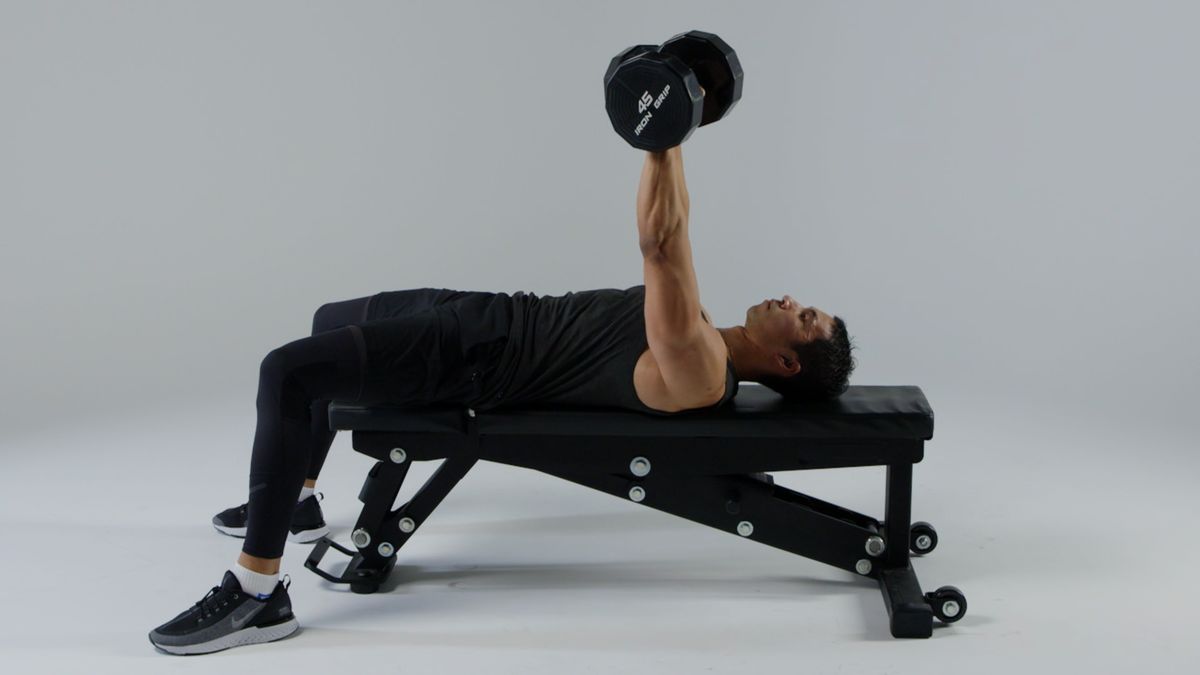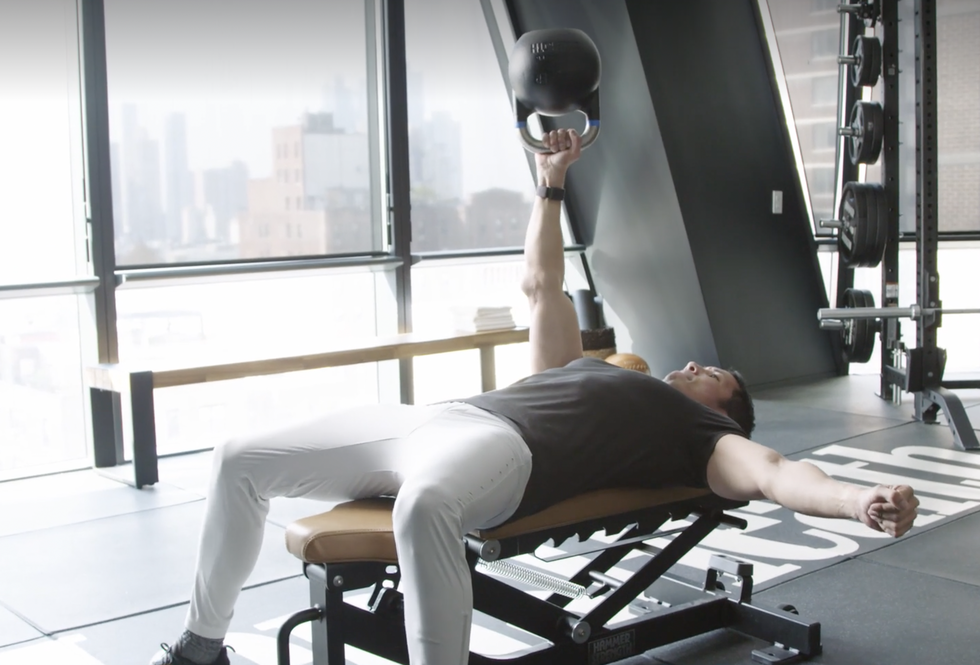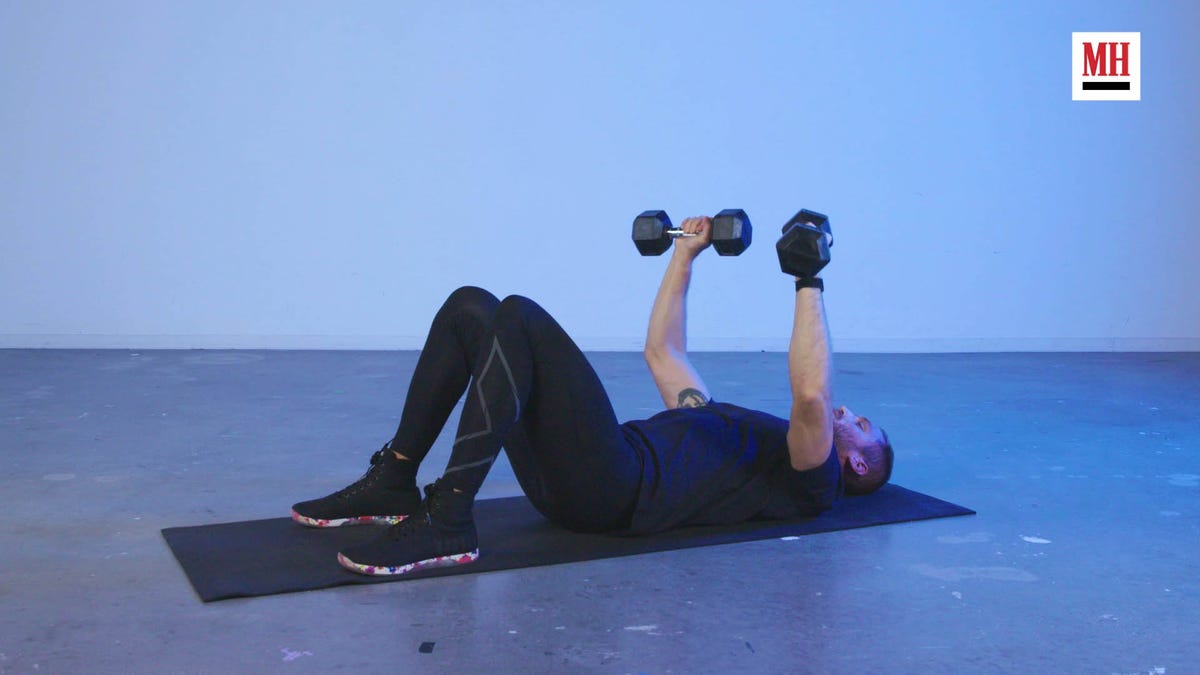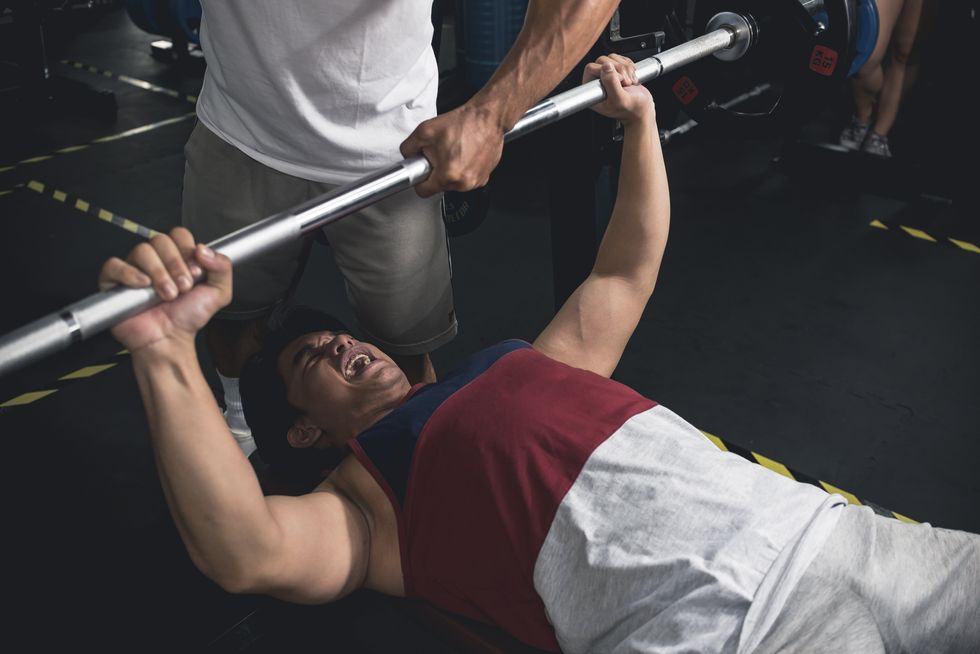THERE’S NO EXERCISE guys love more to anchor their chest day workouts than the classic barbell bench press. It has most of the characteristics a good chest exercise needs: you’ll place a ton of stimulus on the muscle group and it can be progressively overloaded. Do it wrong, however, and you might begin to experience some shoulder pain while bench pressing.
“No matter what kind of lifter you are, there’s a very good chance that you either have dealt with shoulder pain, or you will deal with shoulder pain at some point from this lift,” says Ebenezer Samuel, C.S.C.S., MH fitness director. “That can lead to little issues or more serious issues, depending on how you train and how you deal with that shoulder pain when it arrives.”
Below, Samuel discusses what causes shoulder pain while benching, and four fixes you can implement stop pain in its tracks.
How to Train Your Chest with Shoulder Pain
If you’re already dealing with shoulder pain, there are a few things you can do so you can continue to pursue chest gains while bettering your mechanics to fix the pain you’re dealing with.
Fix 1: Put Down the Barbell
We know it’s hard to put down one of your favorite lifts. If you take a break by choice and focus on shoring up your weak points, you’ll only have to press pause, rather than ruining the barbell bench for the rest of your lifting career. There’s plenty of other equipment and exercises you can use to get those gains until that happens. Here are a few options.
Alternative Exercise 1: Dumbbell Bench Press
The dumbbell bench press still allows for pressing heavy, without the extra stress of the closed chain of the barbell press. It allows you more mobility to un-shrug your shoulders and get your elbows into a proper position.

How to Do It:
- Sit on the bench with your dumbbells. Squeeze your abs and glutes and drive your feet into the floor. Your back should be flush to the bench.
- Raise the dumbbells to shoulder height (use your knees to ‘kick’ them up if you need).
- Drive your shoulders into the back pad of the bench, then press the weight straight up. Keep your arms perpendicular to the ground to keep the proper arm angle.
- Lower the weight back down to the starting position under control. Lower until your elbows are below your shoulders—don’t worry about touching your chest with the dumbbells.
Sets and Reps: Aim for 3 sets of 10 to 12 reps.
Alternative Exercise 2: Kettlebell Bench Press
Kettlebells are an underrated bench press equipment option. The great thing about pressing with kettlebells is “these, very naturally, are going to tip us into a position of shoulder external rotation,” Samuel says. Internal rotation (the opposite) often causes shoulder issues because of the angle it places the strain.

How to Do It:
- Sit on the bench with your kettlebells. Squeeze your abs and glutes and drive your feet into the floor. Your back should be slightly arched.
- Raise the kettlebells to shoulder height (use your knees to ‘kick’ them up if you need). Ensure your wrist stays neutral.
- Drive your shoulders into the back pad of the bench, then press the weight straight up. Keep your arms perpendicular to the ground to keep the proper arm angle.
- Lower the weight back down to the starting position under control. Lower until your elbows are below your shoulders.
Sets and Reps: Aim for 3 sets of 10 to 12 reps.
Alternative Exercise 3: Bottoms-Up Kettlebell Press
The balance required by this lift really forces you to slow down and think about every bit of the movement, including keeping your forearm perpendicular to the ground. It also forces you to go a lot lighter—you’ll be forced to use great technique, or fail.

How to Do It:
- Sit on the bench with one kettlebell, holding it by the handle with the weight up. Squeeze your abs and glutes and drive your feet into the floor. Your back should be slightly arched.
- Raise the kettlebell on its head to shoulder height. Ensure your wrist stays neutral.
- Drive your shoulders into the back pad of the bench, and then press the weight straight up. Keep your arms perpendicular to the ground to keep the proper arm angle.
- Lower the weight back down to the starting position under control. Fight by squeezing your core to maintain your posture.
Sets and Reps: Aim for 3 sets of 6 to 8 reps.
Alternative Exercise 4: Floor Press
The floor press is great for going heavy when you just can’t make it through full range of motion. Likely, you feel that shoulder pain in the lowest portion of the lift, where there’s a stretch through the chest. The floor press takes out that component, so you can keep working the chest with less pain.

How to Do It:
- Lay down on the floor with your kettlebells or dumbbells—either works here. Squeeze your abs and glutes and drive your feet into the floor. Your back should be flushed to the ground.
- Raise the weight to shoulder height. Ensure your wrist stays neutral.
- Drive your shoulders into the floor, then press the weight straight up. Keep your arms perpendicular to the ground to keep the proper arm angle.
- Lower the weight back down to the starting position under control. Lower until elbows rest on the ground. Squeeze the chest to press the weight back up.
Sets and Reps: Aim for 3 sets of 10 to 12 reps.
Fix 2: Reorganize Your Training
If you’re prioritizing your bench and chest training too much and you neglect your back muscles, your chest muscles will shorten and pull you forward. That’s not great for your body mechanics. You want to ensure you’re doing enough back work to pull your shoulders backwards to maintain both good posture and general joint health.
If you’re the person that does full body workouts, do your back exercises before hitting your bench press and other chest exercises. You’ll be able to control the load a bit more when you do get to benching. If you’re more of a push-pull-legs person, do your pull workout before your push workout during the week. This will strengthen your back to help your bench press.
Fix 3: Prioritize Rows
Now that you know to put your back exercises first, it’s important to emphasize your rowing exercises before benching. This will light up the lats and helps the shoulder blades understand path of movement before you get into your chest workout. Aim for at least six sets of some row variation, Samuel says. You can do them with dumbbells, kettlebells, or barbells.
Fix 3: Start With Activation Exercises
Doing activation exercises during your warm up will help situate your shoulder blades into a healthy position, and open up the chest—which will carry over into all your lifts, not just the bench press, Samuel says. You can do these exercises before every workout, or even every day.
Start by massaging the chest with a lacrosse ball, or some other hard ball. Press the ball into your chest up against a wall, and move it around to release any tightness you might have. Work through some active mobilizations, like bringing your arm forward, to the side, and rotating out with a 90 degree bend at the elbow. Do that for about 30 seconds on both sides.
Then, grab a kettlebell and set up into a floor press position. Allow the weight to force your shoulder blade down into the ground, and tighten the shoulder blades together as this happens. “That’s going to help reinforce really good bench press positioning, and have our bodies help to understand that positioning,” Samuel says, especially if you’re already in pain.
What Causes Shoulder Pain When Bench Pressing?

The bench press is a compound movement, meaning several muscle groups at a time are activated to move the weight. That said, you shouldn’t be feeling your shoulders during or after bench pressing.
The muscles in your shoulders might be activated to some extent to provide the lift with stability, but they shouldn’t be utilized to the point of them feeling sore. If that does happen, you’re likely not doing it right. Here are a few common mistakes.
Mistake 1: Your Grip is Too Wide
Placing your hands too far apart on the bar when benching might mean you can move some heavier weight in the short term, but it causes some faulty joint angles that places too much tension across your shoulders.
“If we lose control of the bar, we can very easily tip into a position called internal rotation,” Samuel says. “That’s a position where there’s a lot of mechanism for injury.”
To find the proper grip distance, take an unloaded barbell and place it across your lower chest. From there, find the place where the elbow is about 45 degrees from the ribcage, and your forearms are perpendicular to the ground.
Mistake 2: Improper Bar Path
It’s a common misconception that the barbell should just come straight down to the chest, and straight back up out of it.
In fact, there should be a bit of an arc through the movement. You should start with the wrists, elbows, and shoulders all stacked, and you’ll lower to about your lower chest. Your chest and shoulders will work more optimally this way.
Mistake 3: Not Leading With Your Chest
People often lie down lazily when approaching the bench press. This needs to be an active position, in which your shoulder blades can move.
Fix this by making sure that your shoulders are not “shrugged” up near your ears. Turn your elbows downwards to turn on your lats, then drive your shoulder blades into the bench and squeeze. This should create a slight arch between your upper back and the bench, which allows you to lead with the chest.
